Creativity Sandro Botticelli
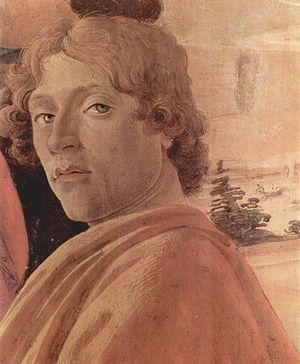
The hero of today’s publication will be another outstanding artist of the Renaissance, known to all as Sandro Botticelli (1445-1510). Although Sandro Botticelli – just a pseudonym, real name of the artist was Alessandro Filipepi. Botticelli was a senior contemporary of such prominent figures of the Renaissance, Leonardo da Vinci, Michelangelo Buonaroti, and Rafaeel Santi. It so happens that the work of Sandro Botticelli appeared as if in the shadow of his more famous younger colleagues, and for a long time, his brilliant paintings were unknown, currently lying somewhere in a warehouse, covered with dust on the margins of history. Only in the 19th century, thanks to the efforts of British scientists and art historian’s brilliant work of this artist was rediscovered and his paintings took their rightful place in the world museums.
Sandro Botticelli was born in the glorious city of Florence in the family of a wealthy tradesman Maria de Vani Filipepi, I received a very good education. Learning the art of painting of the young Botticelli Florentine workshop took place in sculpture and artist Andrea inspections, where he became friends with a young Leonardo da Vinci, who was also a pupil of Andrea Verokio.
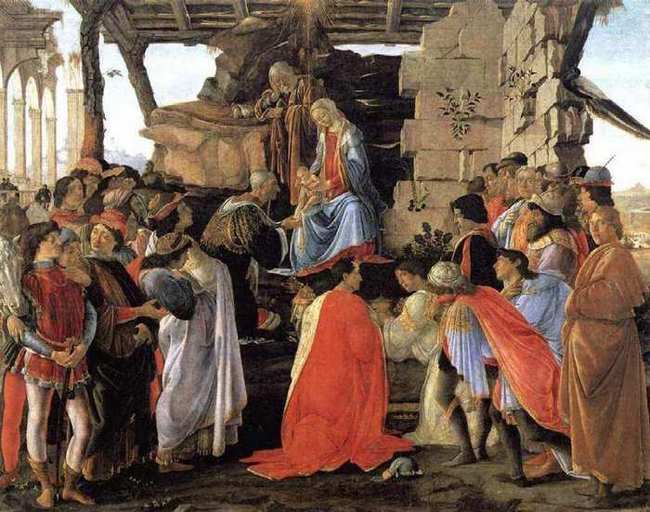
This is one of the first pictures that brought the artistic glory of Botticelli. Its name “Adoration of the Magi.” The theme of the painting is the famous biblical story – the newly born baby Jesus and Mary Mother of God came to bow to the three Magi from the East. However, in the image of the Magi Botticelli painted his contemporaries – the noble members of the Medici family, who at that time ruled the city of Florence. In the foreground on the left part of the picture painted by the artist himself. This picture is liked by Lorenzo de ‘Medici. (At the time, he was a senior member of the family) After that Sandro Botticelli became a painter at the court of the Medici, which was very honorable.
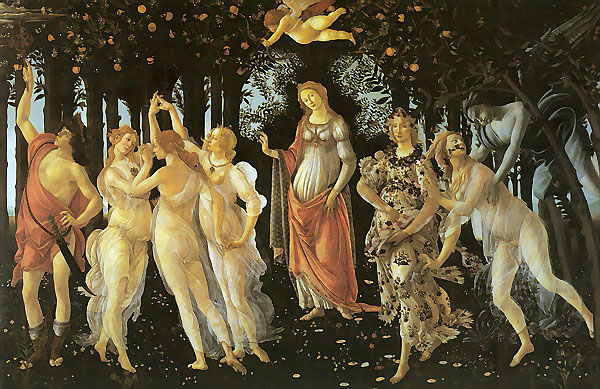
This is one of the most famous paintings of the artist – “Spring”. Made by the artist as a decoration for the Villa Medici, is an allegory of the arrival of spring (and with it the love). In the center of the painting shows a beautiful Venus – the goddess of love. On top of her head flying Cupid, who only thinks – who would shoot their arrows (A spring he shoots some reason most often). To the left of Venus can be seen blooming lady who walks barefoot on the ground gracefully. It Flora – the goddess of spring, according to legend, where stepping her feet, immediately grow flowers, and everything blooms. Near it runs the local nymph of a Faun (apparently it was not without the participation of the Amur) Three girls in the right-hand side of the picture are the Graces, and the young man next to them – Mercury – the messenger of the gods.
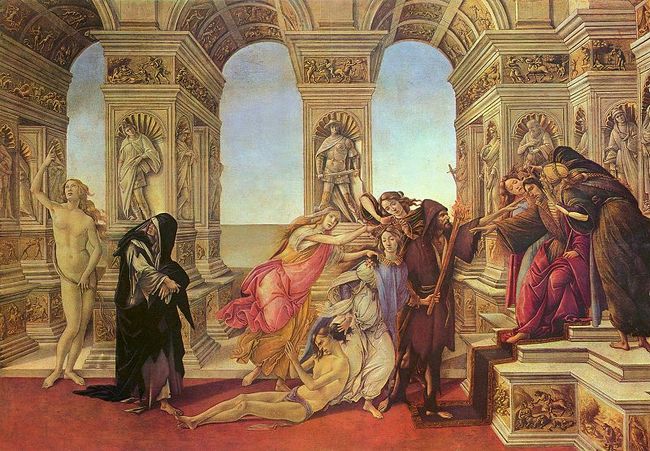
This interesting painting called “slander.” The picture is very allegorical, symbolizing the many human failings, and in particular one of them – it is slander. Slander here is in the form of a beautiful girl with a supposedly innocent face, which involves a man accused in the court of the king. Two other women who braid hair libel symbolize Intrigue and Lies. The man with the torch, which comes ahead of Slander is Envy. Sitteth on the throne of the king, two ear whisper Ignorance and Suspicion. In the right part of the picture Repentance is presented in the form of an old woman dressed in black mourning clothes, and beside her naked Truth looking somewhere up.
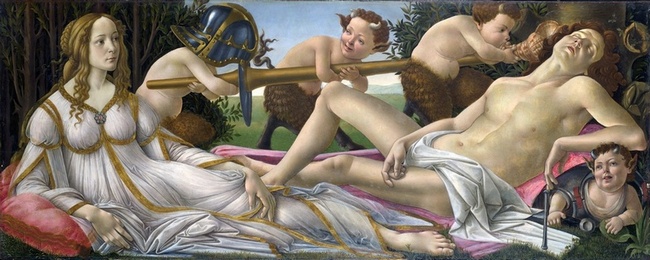
This painting “Venus and Mars” written by the artist commissioned by the well-known family of Florentine Vespucci. (It was in honor of one of the members of the family – the Florentine explorer Amerigo Vespucci, the American continent has been called “America”) The painting depicts a beautiful goddess of love, Venus and Mars, the god of war snooty. As you can see in the picture – Mars asleep, lulled love war. The famous slogan of the time of 60-ies of the last century (during the US war in Vietnam) “Make love not war” (make love, not war) was relevant at all times. The painting symbolizes the victory of love over war, love or is awake, asleep war.
The paintings of Botticelli enjoyed great popularity among the educated Florentines. But in the second half of the life of the artist, his work has changed dramatically. Sandro Botticelli was a very passionate religious person, and so it took much fervent sermons Dominican monk Savonarola, who urged them all to repent, threatening swift end of the world. (These fanatics in our time, unfortunately, there) In its fanatical, ecstatic sermons Savonarola declared relentless war on wealth, luxury, various earthly pleasures (especially such as music and dance). His sermons had great success among ordinary Florentines, and after the death of Lorenzo de ‘Medici, Savonarola actually began to rule Florence. In the inner world of Botticelli for a long time there was a struggle between the humanistic values of the Renaissance culture and calls for repentance and asceticism, sounded from the lips of Savonarola.
Across Florence burned bonfires, where the followers of Savonarola burned books, gold and silver jewelry, luxury goods, and in particular the priceless works of art, paintings, sculptures. Botticelli being fanatical delighted with the barbaric ideas of Savonarola, personally burned some of his early paintings. At the end of life, in his work by Botticelli completely abandoned all the antique in the pictures, but all of his paintings began to focus on a purely Christian subjects.
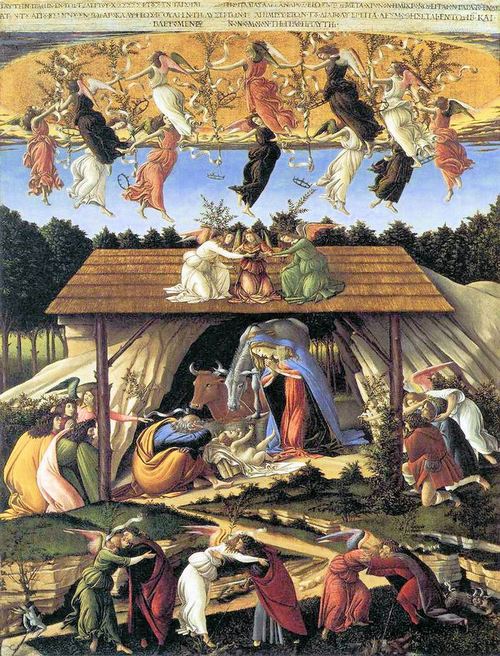
This is one of the late artist’s paintings – “The Mystic Nativity”. In addition to the biblical story on the theme of the birth of Jesus Christ, the painting passed apocalyptic mood that prevailed in the surroundings of the artist at the time. Angels in the picture hugging each other, soon will come Judgment Day. The technical design of the picture is markedly different from the Renaissance style typical of the artist’s earlier paintings. The creative path of the artist – a heavy and tragic, from the dreamy mood of pessimism painful adolescence to adulthood.
And in conclusion I would like to come back in the early years of Botticelli, the painting, which was the culmination of his genius and talent. Your attention, “Birth of Venus”
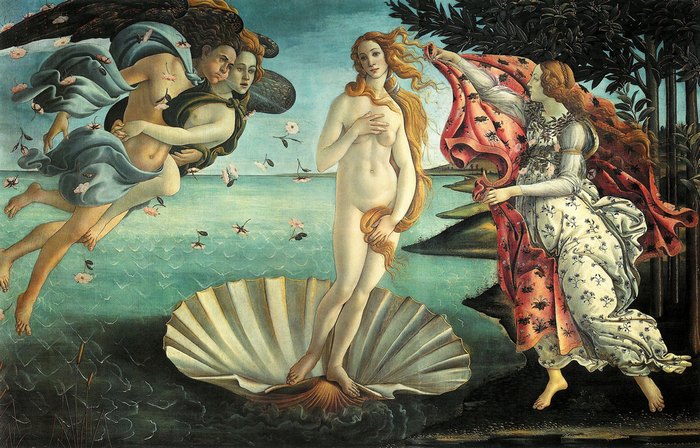
The painting was done in the well-known ancient myth about the birth of foam beautiful goddess of love Venus, which is represented in the picture in the form of a beautiful dreamy girl. On the left is depicted a nymph, which cover a hurry Madam Venus veil. Right gentle west wind Zephyr carries on its wings Flor Spring. (The theme of spring and love is inextricably linked to the paintings of Botticelli). I wish all readers of the rule of spring and love in your life.